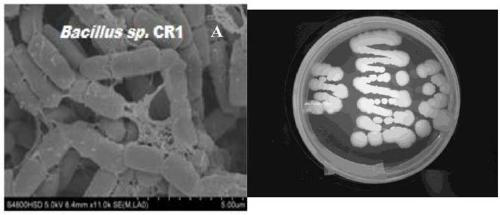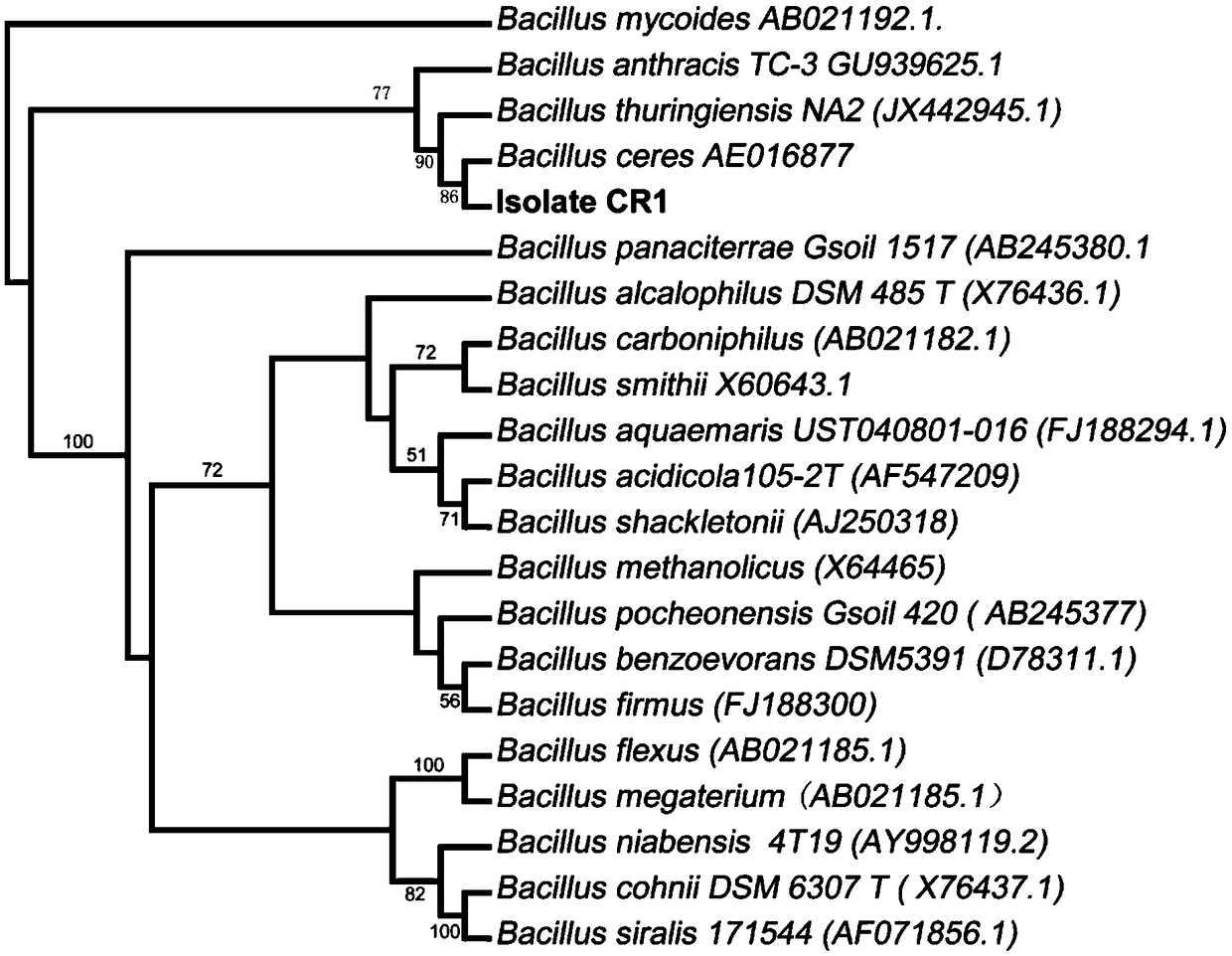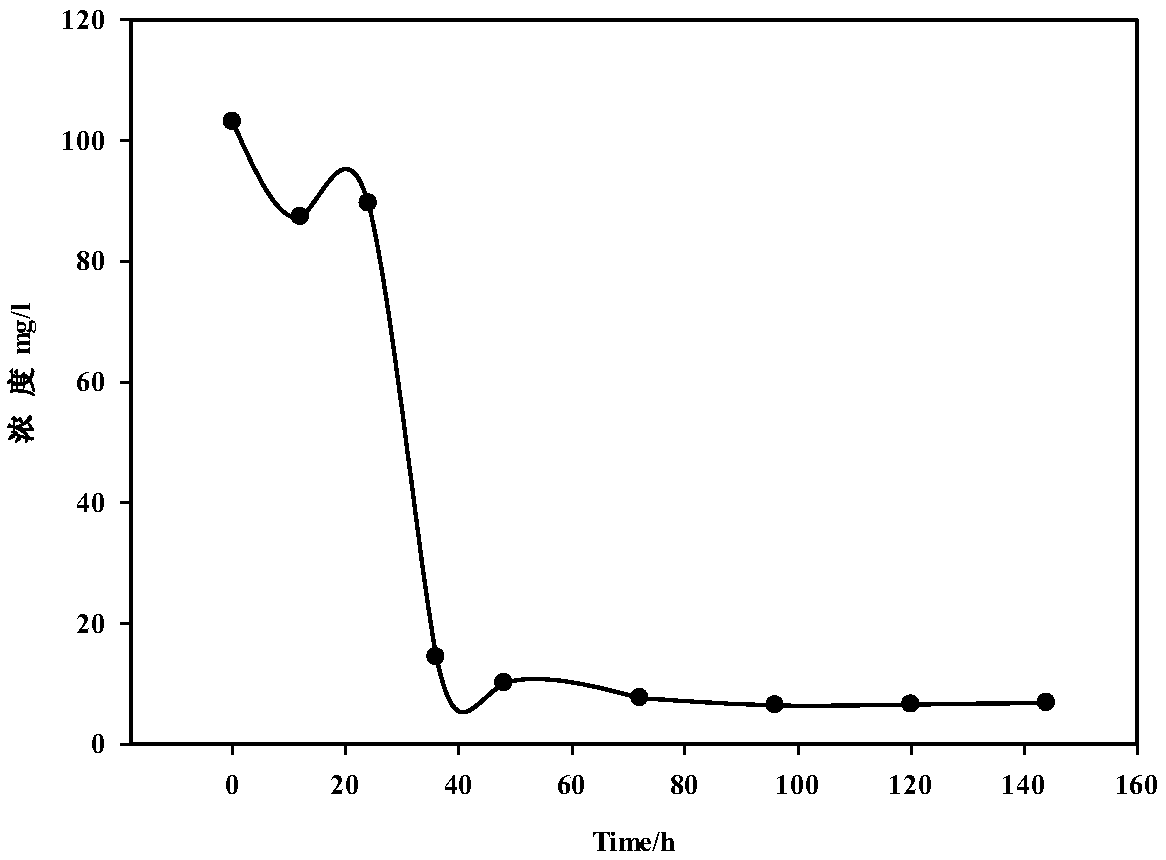Bacillus capable of degrading naphthenic acids and application of bacillus capable of degrading naphthenic acids
A bacillus, naphthenic acid technology, applied in the direction of bacteria, microorganism-based methods, biochemical equipment and methods, etc.
- Summary
- Abstract
- Description
- Claims
- Application Information
AI Technical Summary
Problems solved by technology
Method used
Image
Examples
Embodiment 1
[0026] Example 1. Isolation, purification and identification of strain CR1.
[0027] Strain CR1 was isolated from oil sands, and the specific enrichment, separation, and purification processes were as follows:
[0028] Basic inorganic salt medium (MSM medium) consists of: KH 2 PO 4 1.36g, (NH 4 ) 2 SO 4 0.66g, Na 2 HPO 4 0.43g, MgSO 4 ·7H 2 O 0.25g, trace element solution 10mL, distilled water 990mL.
[0029] The composition of the trace element solution is: Ca(NO 3 ) 2 4H 2 0800mg / L, FeSO 4 ·7H 2 O 400mg / L, CuSO 4 ·5H 2 O 80mg / L, ZnSO 4 ·7H 2 O 40mg / L, MnSO 4 4H 2 O 40mg / L, NaMO 4 2H 2 O 8mg / L, H 3 BO 3 6mg / L, K 2 HPO 4 500mg / L, the rest is distilled water.
[0030] Add agarose with a mass percent content of 1.5-1.8% to the MSM medium, and sterilize under the condition of 0.06MPa for 20min. After the sterilized MSM culture medium was cooled to 50-60°C, trans-4-methyl-cyclohexane acid was added to make the concentration 50 mg / L. At the same time, th...
Embodiment 2
[0039] Example 2. The degradation profile of bacterial strain CR1 to naphthenic acid
[0040] In order to study the degradation spectrum of naphthenic acid by strain CR1, MSM was used as the basic medium, and the growth of the strain on five kinds of naphthenic acid with different chemical structures as the only external carbon source was investigated respectively. The experiment adopts the method of solid culture, at 28 ℃, static culture for one week, observe the situation of colony formation. Table 1 shows the results of strain CR1 degrading five different naphthenic acids.
[0041] Table 1 The degradation and utilization of naphthenic acid by strain CR1
[0042]
[0043] Note: "+" in the table indicates the growth of bacteria on the corresponding naphthenic acid plate.
[0044] The more "+" means the better the growth of the bacteria and the better the biodegradation of naphthenic acid
[0045] It can be seen from Table 1 that: (1) bacterial strain CR1 has a wide degr...
Embodiment 3
[0046] Example 3. Biodegradation of trans-4-methyl-cyclohexanecarboxylic acid by strain CR1
[0047] Inoculate the preserved bacteria in the LB enriched medium containing 100mg / L trans-4-methyl-cyclohexanecarboxylic acid, grow to the optimum bacterial age, then centrifuge the bacteria at 4000rpm for 10min to collect the bacteria, wash Afterwards, the bacteria were inoculated into the MSM medium containing 100mg / L trans-4-methyl-cyclohexanecarboxylic acid, samples were taken at regular intervals, and the residual concentration of trans-4-methyl-cyclohexanecarboxylic acid was measured to draw the Degradation curve, see the results image 3 . After 144 hours of reaction, the final concentration of trans-4-methyl-cyclohexanecarboxylic acid was 6.84mg / L, and the degradation rate could reach 93.2%. It can be seen that the screened bacterial strain has a high degradation efficiency to trans-4-methyl-cyclohexanecarboxylic acid.
PUM
 Login to View More
Login to View More Abstract
Description
Claims
Application Information
 Login to View More
Login to View More - R&D
- Intellectual Property
- Life Sciences
- Materials
- Tech Scout
- Unparalleled Data Quality
- Higher Quality Content
- 60% Fewer Hallucinations
Browse by: Latest US Patents, China's latest patents, Technical Efficacy Thesaurus, Application Domain, Technology Topic, Popular Technical Reports.
© 2025 PatSnap. All rights reserved.Legal|Privacy policy|Modern Slavery Act Transparency Statement|Sitemap|About US| Contact US: help@patsnap.com



